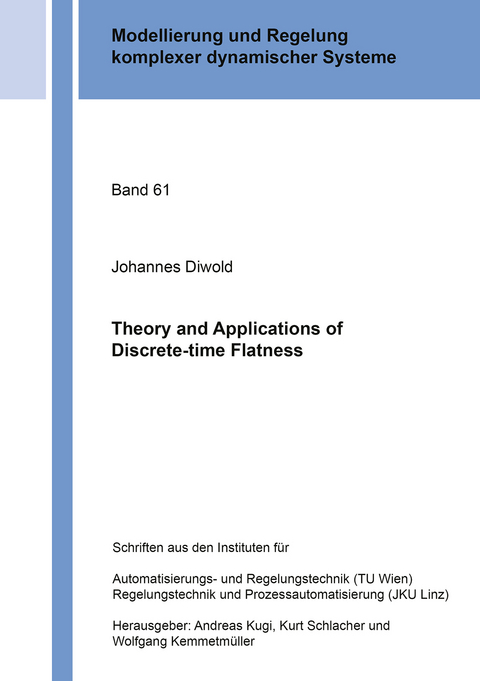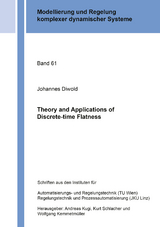Theory and Applications of Discrete-time Flatness
Seiten
Eines der unumstritten wichtigsten Konzepte der Regelungstheorie wurde in den 1990ern unter dem Namen Flachheit von Fliess, Lévine, Martin und Rouchon eingeführt. Ein zu regelndes System wird als flach bezeichnet, wenn alle Lösungen/Trajektorien dieses Systems durch einen sogenannten flachen Ausgang und dessen Zeitableitungen parametriert werden können. Mithilfe dieser Systemeigenschaft, die zudem viele physikalische Systeme aufweisen, ist es möglich sehr einfach Trajektorien bzw. Vorsteuerungen zu planen und Folgeregelungen zu entwerfen. In der Praxis werden solche Regelungen nahezu ausschließlich auf einem Digitalrechner/Prozessor mit endlicher Abtastrate implementiert. Weist das zu regelnde System allerdings eine vergleichsweise hohe Dynamik auf, kann eine zeitdiskrete Auswertung des zeitkontinuierlich entworfenen Regelgesetzes zu ungewünschtem oder auch instabilem Verhalten führen. Daher widmet sich die vorliegende Arbeit der Theorie zeitdiskreter Flachheit sowie praktische Anwendungen zeitdiskreter Flachheit. Für eine geeignete Charakterisierung zeitdiskreter flacher Systeme werden im ersten Teil einige differentialgeometrische Konzepte wiederholt. Diese erlauben es nicht nur eine rigorose Definition für zeitdiskrete Flachheit anzugeben, sondern auch Methoden zur Überprüfung dieser Eigenschaft für spezielle Systemklassen zu entwickeln. Im zweiten Teil steht die praktische Anwendung im Vordergrund. In diesem Zusammenhang werden Methoden vorgestellt, die es erlauben, nichtlineare Systeme zu diskretisieren, ohne dabei die Eigenschaft der Flachheit zu zerstören. Für das flache Abtast-Modell können anschließend sehr einfach Trajektorien geplant und Folgeregelungen systematisch entworfen werden. In the 1990s, the concept of flatness was introduced by Fliess, Lévine, Martin and Rouchon for nonlinear continuous-time systems. Continuous-time flat systems have the characteristic feature that all system variables can be parameterized by a flat output and its time derivatives. Their popularity stems from the fact that a lot of physical systems possess the property of flatness and that the knowledge of a flat output allows an elegant solution to motion planning problems and a systematic design of tracking controllers. In practical applications, nevertheless, such continuous-time control laws are usually implemented on digital computers/processors with finite sampling rates. However, if the dynamics of a system is high compared to the sampling rate, a discrete evaluation of a continuous-time control law may lead to unsatisfactory results or even unstable behavior. As known from linear control theory, designing a controller for a suitable discretization (sampled-data system) is an appropriate alternative. Due to these considerations, in this thesis, we discuss the concept of flatness as well as flatness-based control strategies within the discrete-time framework.
This work can be divided into two parts: the theory of discrete-time flatness and practical applications of discrete-time flatness. For the first part, we will recall basic differential-geometric concepts in order to characterize discrete-time flat systems. In addition to a rigorous definition of discrete-time flatness, these geometric concepts allow us to formulate methods to check this property for a particular class of systems. The second part focuses on practical applications. In this context, methods will be presented that allow discretizing nonlinear systems without losing the flatness property. Once a flat sampled-data system is obtained, trajectories can be easily planned and tracking controllers systematically designed. By means of the laboratory setup of a gantry crane, we show that with respect to low sampling rates, the discrete-time flatness-based controller is indeed more robust than the classical continuous-time approach.
This work can be divided into two parts: the theory of discrete-time flatness and practical applications of discrete-time flatness. For the first part, we will recall basic differential-geometric concepts in order to characterize discrete-time flat systems. In addition to a rigorous definition of discrete-time flatness, these geometric concepts allow us to formulate methods to check this property for a particular class of systems. The second part focuses on practical applications. In this context, methods will be presented that allow discretizing nonlinear systems without losing the flatness property. Once a flat sampled-data system is obtained, trajectories can be easily planned and tracking controllers systematically designed. By means of the laboratory setup of a gantry crane, we show that with respect to low sampling rates, the discrete-time flatness-based controller is indeed more robust than the classical continuous-time approach.
| Erscheinungsdatum | 12.05.2023 |
|---|---|
| Reihe/Serie | Modellierung und Regelung komplexer dynamischer Systeme ; 61 |
| Verlagsort | Düren |
| Sprache | englisch |
| Maße | 148 x 210 mm |
| Gewicht | 249 g |
| Themenwelt | Sachbuch/Ratgeber ► Natur / Technik ► Technik |
| Technik ► Elektrotechnik / Energietechnik | |
| Schlagworte | Discrete-time flatness • discretizing nonlinear systems • property of flatness • Sampled-data Control • Time flat systems |
| ISBN-10 | 3-8440-9057-6 / 3844090576 |
| ISBN-13 | 978-3-8440-9057-4 / 9783844090574 |
| Zustand | Neuware |
| Haben Sie eine Frage zum Produkt? |
Mehr entdecken
aus dem Bereich
aus dem Bereich
die wichtigsten Begriffe, Bautypen und Bauelemente
Buch | Softcover (2024)
Prestel (Verlag)
CHF 44,75
Buch | Hardcover (2021)
C. Bertelsmann (Verlag)
CHF 25,20
vom Kolosseum über die Akropolis bis zur Alhambra
Buch | Hardcover (2023)
DK (Verlag)
CHF 29,90




